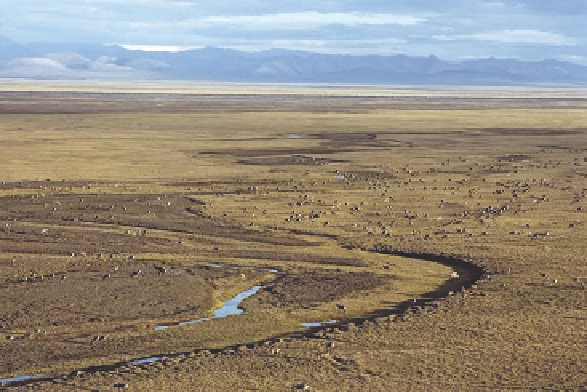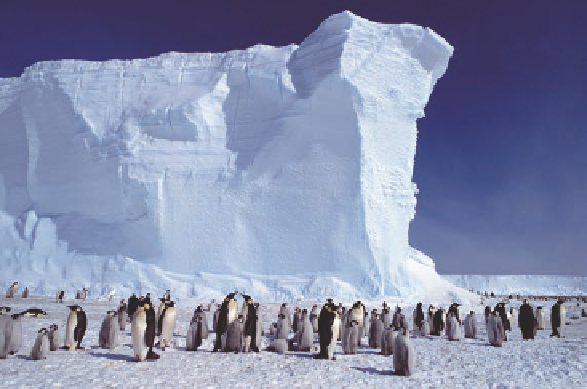Geoscience Reference
In-Depth Information
2.
The humid continental hot-summer climates (
Dfa
,
Dwa
)
occur in places like the midwestern United States and
eastern Asia. Vegetation consists largely of deciduous
trees. These regions have wide annual temperature
ranges and moderate yearly precipitation. Most precipi-
tation is associated with midlatitude cyclones.
3.
The humid continental mild-summer climates (
Dfb
,
Dwb
)
occur in places like the north-central and northeastern
United States and eastern Asia. Vegetation consists
dominantly of needle-leaf trees. These regions also
have a wide annual temperature range, but with colder
winters and milder summers than the humid continental
hot-summer climates (
Dfa
,
Dwa
). Average annual pre-
cipitation is moderate and most closely associated with
the midlatitude storm track.
(a)
4.
The subarctic climates (
Dfc
,
Dwc
,
Dwd
) occur in high-
latitude, continental locations that span North America
and Asia. Vegetation is boreal forest. These regions
have a very wide annual temperature range and have
a summer wet season associated with the midlatitude
storm track.
In contrast to the tundra climate, the ice-cap climate (
EF
)
occurs in the interior of Greenland and Antarctica where enor-
mous glaciers cover the landscape. Sun angle is consistently
very low in these areas, resulting in little annual insolation.
In addition, the ice-covered surfaces have high albedo, which
means that most radiation is reflected and thus provides no heat.
As a result, temperatures are consistently brutally cold to frigid
(Figure 9.13b). At McMurdo Station in Antarctica, for example,
average annual high temperatures range from
-
5°C (25°F) in
December to
-
27°C (
-
17°F) in July and August. (
Why do the
coldest temperatures occur in July and August?
) Annual precipi-
tation is very low,
<
8 mm (0.3 in.). The reason for this low pre-
cipitation is that the air over the Antarctic ice cap is continental
antarctic (cAA) air, which is very cold and dry. In short, this
place is a polar desert.
(b)
Figure 9.13 The polar climates (
E
).
(a) Vegetation in the tundra
landscape consists of low-lying lichens and mosses, which are
the main diet of caribou. (b) A scene from the Antarctic ice cap
where temperatures are frigid year round.
precipitation falls in this region, largely because it is dominated
by the polar high-pressure system the vast majority of the year.
The vegetation in this climate region is characterized by short
mosses and lichens that dominate the landscape (Figure 9.13a).
These areas also contain well-developed bogs and zones of per-
mafrost, which will be investigated in more detail in Chapter 17.
Highland (
H
) Climates
Thus far the discussion about Köppen climates has largely
focused on climate zones influenced by changes in latitude.
The system also recognizes highland (
H
) climates, which are
those associated with the world's large mountain ranges such
as the Andes in South America, the Himalayas in Asia, the
Swiss Alps in Europe, the Southern Alps in New Zealand, and
the Rockies in North America (Figure 9.2).
H
climates are
largely determined on the basis of the temperature changes
associated with the environmental lapse rate as it relates to
altitude. Recall from Chapter 5 that this value is 6.4°C/km
(3.5°F/1000 ft). Perhaps you have observed when hiking in
mountains that temperatures usually become cool with in-
creased elevation. Or perhaps you have noticed that moun-
tain peaks may be covered with snow while it is hot in the
surrounding lowlands.
KEY CONCEPTS TO REMEMBER ABOUT
MICROTHERMAL (d) CLIMATES
1.
Three major subcategories of microthermal (
D
) climates
are recognized: (a) humid continental hot-summer cli-
mates (
Dfa
,
Dwa
); (b) humid continental mild-summer
climates (
Dfb
,
Dwb
); and (c) subarctic climates (
Dfc
,
Dwc
,
Dwd
).



